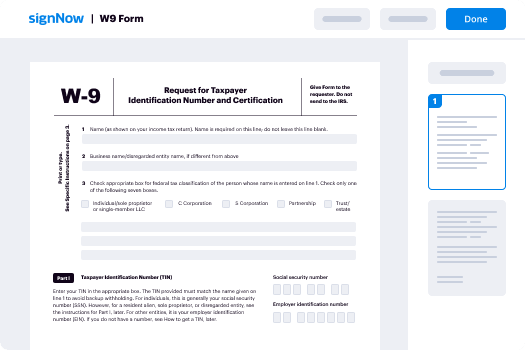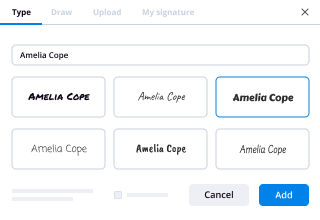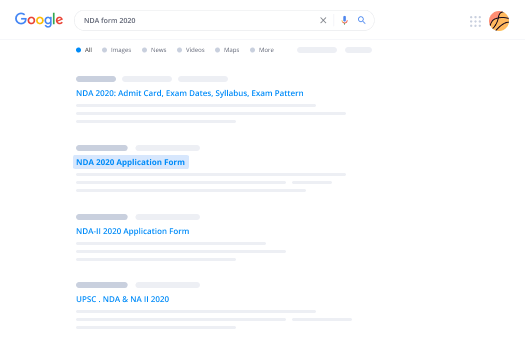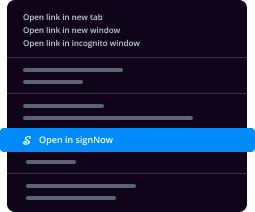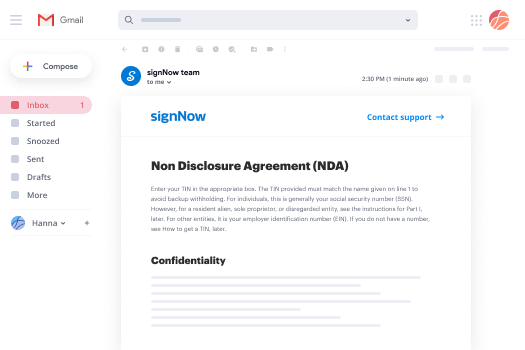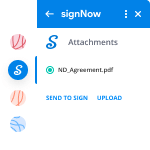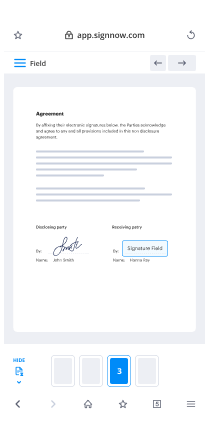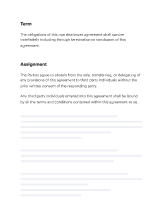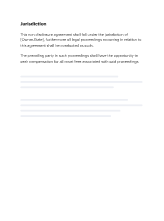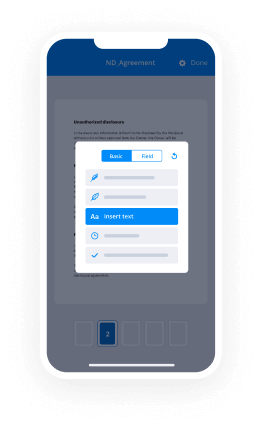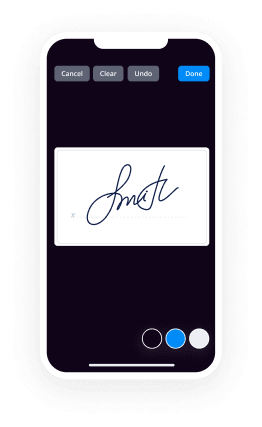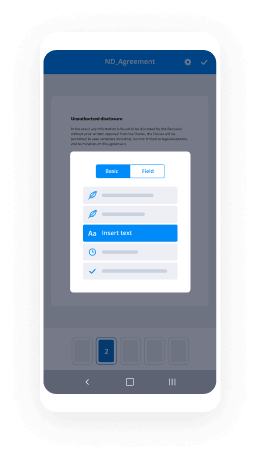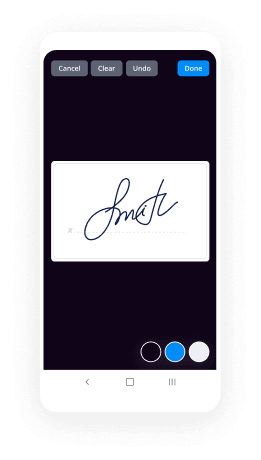Firma Digital Vs Firma Electrónica
- Rápido para iniciar
- Fácil de usar
- Soporte 24/7
Las empresas con visión de futuro de todo el mundo confían en SignNow






Guía rápida sobre cómo usar la función digital vs electronic
¿Está su organización lista para reducir ineficiencias en tres cuartas partes o más? Con airSlate SignNow eSignature, semanas de negociación de contratos se convierten en días, y horas de recolección de firmas se transforman en unos pocos minutos. No necesitará aprender todo desde cero gracias a la interfaz intuitiva y las instrucciones fáciles de seguir.
Siga los siguientes pasos a continuación para usar la funcionalidad digital vs electronic sign en unos pocos minutos:
- Inicie su navegador y visite signnow.com.
- Regístrese para una prueba gratuita o inicie sesión usando su correo electrónico o credenciales de Google/Facebook.
- Haga clic en Avatar de Usuario -> Mi Cuenta en la parte superior derecha de la página web.
- Personalice su Perfil de Usuario con sus datos personales y ajuste configuraciones.
- Diseñe y gestione su(s) Firma(s) Predeterminada(s).
- Regrese a la página del panel de control.
- Desplace el cursor sobre el botón Subir y Crear y elija la opción adecuada.
- Haga clic en el botón Preparar y Enviar junto al título del documento.
- Ingrese el nombre y la dirección de correo electrónico de todos los firmantes en el cuadro emergente que se abre.
- Utilice la opción Comenzar a agregar campos para proceder a modificar el archivo y firmarlo usted mismo.
- Haga clic en GUARDAR E INVITAR cuando haya terminado.
- Continúe configurando su flujo de trabajo de eSignature utilizando más funciones.
No puede ser más fácil usar la función digital vs electronic signature. También está disponible en sus dispositivos móviles. Instale la aplicación airSlate SignNow para iOS o Android y gestione sus flujos de trabajo de eSignature personalizados incluso mientras está en movimiento. Olvídese de imprimir y escanear, de la presentación de documentos que consume tiempo y del costoso envío de papeles.
Cómo funciona
Califica tu experiencia
What is digital vs electronic?
The terms "digital" and "electronic" are often used interchangeably, but they have distinct meanings, especially in the context of signatures. A digital signature is a specific type of electronic signature that uses cryptographic techniques to secure the authenticity and integrity of a document. Electronic signatures, on the other hand, encompass a broader range of methods for signing documents electronically, including scanned handwritten signatures, typed names, or clicks to accept terms. Understanding this distinction is crucial when navigating the eSignature process.
Steps to complete the digital vs electronic
Completing a document using digital or electronic signatures involves several key steps:
- Upload the document to airSlate SignNow’s platform.
- Choose the signature method: digital or electronic.
- Fill out any required fields within the document.
- Request signatures from other parties by entering their email addresses.
- Send the document for signature.
- Once all parties have signed, the completed document is securely stored and can be downloaded.
Legal use of the digital vs electronic
In the United States, both digital and electronic signatures are legally recognized under the Electronic Signatures in Global and National Commerce (ESIGN) Act and the Uniform Electronic Transactions Act (UETA). These laws establish that electronic signatures hold the same legal weight as traditional handwritten signatures, provided that all parties consent to use electronic means for signing. It is essential for users to ensure compliance with these regulations when utilizing eSignatures in their workflows.
Security & Compliance Guidelines
When using digital or electronic signatures, security and compliance are paramount. Users should consider the following guidelines:
- Utilize platforms like airSlate SignNow that offer encryption and secure storage for documents.
- Ensure that the identity of signers is verified through multi-factor authentication.
- Maintain an audit trail that logs all actions taken on the document, including who signed and when.
- Regularly review and update security protocols to align with industry standards.
Examples of using the digital vs electronic
Digital and electronic signatures can be applied across various scenarios, including:
- Contracts: Businesses can quickly finalize agreements without the need for physical meetings.
- HR documents: Employee onboarding forms can be signed electronically, streamlining the hiring process.
- Legal documents: Attorneys can send and receive signed documents securely, ensuring confidentiality.
- Real estate transactions: Buyers and sellers can sign agreements remotely, expediting the closing process.
Sending & Signing Methods (Web / Mobile / App)
airSlate SignNow provides flexible options for sending and signing documents. Users can:
- Access the platform via a web browser for desktop signing.
- Use the mobile app to sign documents on the go, ensuring convenience.
- Send documents for signature directly from integrated tools like Google Docs or CRM systems.
¡Obtenga ahora firmas vinculantes desde el punto de vista jurídico!
-
Mejor ROI. Nuestros clientes logran un promedio de 7x ROI en los primeros seis meses.
-
Se adapta a sus casos de uso. De las PYMES al mercado medio, airSlate SignNow ofrece resultados para empresas de todos los tamaños.
-
Interfaz de usuario intuitiva y API. Firma y envía documentos desde tus aplicaciones en minutos.
Firma en línea FAQs
-
What is the difference between digital vs electronic signatures?
Digital signatures use cryptographic techniques to provide a higher level of security and authenticity, while electronic signatures are a broader category that includes any electronic indication of agreement. Understanding the difference between digital vs electronic signatures is crucial for businesses looking to ensure compliance and security in their document processes. -
How does airSlate SignNow handle digital vs electronic signatures?
airSlate SignNow offers both digital and electronic signature options, allowing users to choose the method that best fits their needs. This flexibility ensures that businesses can comply with various regulations while enjoying the benefits of a streamlined signing process. -
What are the pricing options for airSlate SignNow?
airSlate SignNow provides various pricing plans to accommodate different business sizes and needs. By comparing the features included in each plan, you can determine which option best supports your requirements for managing digital vs electronic signatures. -
What features does airSlate SignNow offer for managing documents?
airSlate SignNow includes features such as customizable templates, automated workflows, and real-time tracking of document status. These tools enhance the efficiency of managing both digital vs electronic signatures, making it easier for businesses to streamline their document processes. -
Can airSlate SignNow integrate with other software?
Yes, airSlate SignNow integrates seamlessly with various third-party applications, including CRM and project management tools. This capability allows businesses to enhance their workflows and manage digital vs electronic signatures more effectively across different platforms. -
What are the benefits of using airSlate SignNow for electronic signatures?
Using airSlate SignNow for electronic signatures offers numerous benefits, including increased efficiency, reduced paper usage, and enhanced security. By understanding the advantages of digital vs electronic signatures, businesses can make informed decisions that improve their overall document management processes. -
Is airSlate SignNow compliant with legal standards for signatures?
Yes, airSlate SignNow complies with various legal standards, including the ESIGN Act and UETA, ensuring that both digital and electronic signatures are legally binding. This compliance is essential for businesses that want to ensure the validity of their signed documents.
Tu guía completa de cómo hacerlo
Solución confiable de eSignature
Únase a más de 28 millones de usuarios de airSlate SignNow
Obtener más
- Descubre cómo cambiar la fuente de la firma en Adobe ...
- Descubre Cómo Cambiar Tu Firma para Outlook ...
- Descubre cómo cambiar la firma en Outlook Web App 2010 ...
- Cómo cambiar la firma de Outlook
- Descubre Cómo Cambiar la Firma en Adobe Reader con ...
- Desbloquea el Poder del Cambio: Descubre Cómo Cambiar ...
- Aprende cómo cambiar la firma en el correo ...
- Aprenda Cómo Cambiar la Firma Usted Mismo en Adobe con ...




















